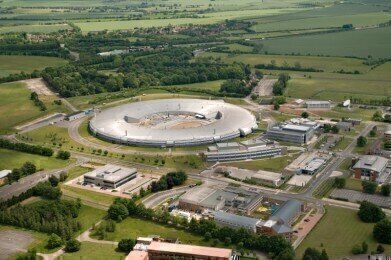-
 Diamond Light Source facility
Diamond Light Source facility
News
Insights into Spin Dynamics of Topological Insulators.
Jul 03 2015
UK scientists from the Central Laser Facility and Diamond Light Source, have been working as part of a European collaboration that has successfully gained new insights into the excited state spin dynamics of topological insulators. Using a technique known as Spin,Time and Angle Resolved Spectroscopies (STARS), on the ultrafast infrared lasers available on the Nanoscience beamline (I06), the team reports* on the spin-dependent scattering between bulk and surface states in the archetypal topological insulator Bi2Se3.
Dr. Cephise Cacho, from STFC’s Central Laser Facility, explains the research, “There is currently wide interest in the idea of being able to optically induce and control a spin-polarised current in spintronic devices. However, we know that there is a very complex interplay between the electrons photoexcited into the spin-polarized surface states and the bulk spin-degenerate states. The out-of-equilibrium electronic and spin structure of topological insulators has revealed some novel dynamics at work in topological insulators.”
The collaboration, involved researchers from academic institutes and facilities across 8 European countries, who spent 6 months preparing for these experiments at Diamond and then over a month taking measurements in the Nanoscience beamline’s new laser cabin. The experiments revealed the existence of a surface resonance state in the second bulk band gap which significantly affected the relaxtion of the different spin channels. Furthermore, the experimental results were fully explained using relativistic ab initio spin-resolved photoemission calculations.
Dr. Cacho continues “We have shown that the newly discovered surface resonance state plays a crucial role in the ultrafast dynamics of topological insulators and acts as a bottleneck for the interaction between the topologically protected surface state and the bulk conduction band. We also found that the spin-polarization dynamics in momentum space show that these states display macroscopically different temperatures and, more importantly, different cooling rates over several picoseconds. This research is of fundamental importance for future opto-spintronic devices, since the bulk states could be responsible for effects such as a net photogalvanic current.”
Prof. Sarnjeet Dhesi adds “On beamline I06 we have used the femotosecond lasers to understand ultrafast spin-polarised dynamics in topological insulators in this study. The lasers are also used in a programme of study involving Resonant Soft X-ray Diffraction which we have developed as an ultrafast probe of strongly-correlated systems at Diamond and X-Ray Free Electron Lasers.”
For more information about beamline I06 and the laser cabin, or to discuss potential applications for beamtime, please contact principal beamline scientist Prof. Sarnjeet Dhesi: dhesi@diamond.ac.uk
*Results in Physical Review letters, March 4, 2015
Digital Edition
Lab Asia Dec 2025
December 2025
Chromatography Articles- Cutting-edge sample preparation tools help laboratories to stay ahead of the curveMass Spectrometry & Spectroscopy Articles- Unlocking the complexity of metabolomics: Pushi...
View all digital editions
Events
Jan 21 2026 Tokyo, Japan
Jan 28 2026 Tokyo, Japan
Jan 29 2026 New Delhi, India
Feb 07 2026 Boston, MA, USA
Asia Pharma Expo/Asia Lab Expo
Feb 12 2026 Dhaka, Bangladesh


















